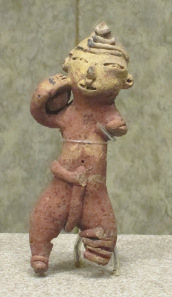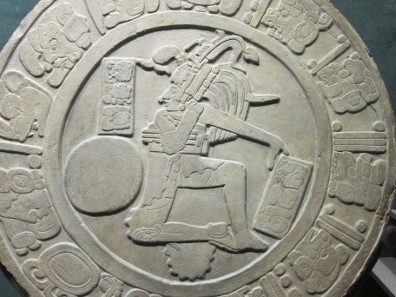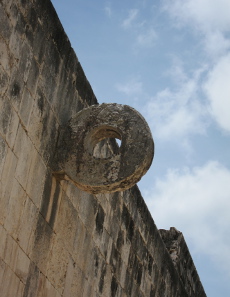translated by Honeycutshome
When Hernan Cortez returned to Spain in 1528, he brought some Aztec captives with him that, much to the delight of Charles V and his royal court, presented a somewhat weird ball game. Almost naked, wearing only a padded loincloth and gloves with no fingers, the men played with a ball made of rubber with their hips and buttocks. The Spanish interest was not so much aroused by the indecent movements of the players. They were much more fascinated with the ball instead. Admittedly, balls were known in Spain, too, but they were made of leather, stuffed with wool or hair. Something as bouncing as the Aztec caoutchuc ball was hitherto unknown in the Western world.
Perhaps the earliest depiction of a ball player. Tlatilco, Mexico, 3rd-4th cent. B. C. National Museum of Culture / Mexico City. Photograph: UK.
The Spanish audience did not care at all about the fact that the ball game was an age-old tradition of the Mesoamerican peoples. Probably ball games had been played already in Teotihuacan, in honor of the gods. We know for sure that the Mayas did just that. They left us the Popol Vuh, the sacred book of the Quiché-Mayas of Guatemala, which narrates the myth surrounding the origin of the very first ball game.
“Disc of Chinkultic”, with the depiction of a ball player in the middle. National Museum of Culture / Mexico City. Photograph: UK.
Once the gods of the underworld were infuriated by the two brothers ‘One-Hunahpu’ and ‘Seven-Hunahpu’ who were constantly playing ball. The gods consequently killed the keen players to teach the humans a lesson. Their inconsolable mother afterwards hid the gaming equipment. Her grandchildren, however, found it all the same and they – as we are told by the Popol Vuh – went away to play in the ball court.
Figure of a ball player. 6th cent. A. D. National Museum of Culture / Mexico City. Photograph: UK.
Hence, the gods again felt disturbed by the ball players clomping on top of their heads. They sent the bird Voc in order to call the young men to court. And they ordered the captives to compete with them, i.e. the gods.
Figure of a ball player. 6th cent. A. D. National Museum of Culture / Mexico City. Photograph: UK.
The gods of course tried to trick the young men. They hid a dagger in the ball that might have killed a player with no experience at an instant. Their human competitors, however, were aware of the gods’ intentions. They fought the gods of the underworld and overpowered them.
Great Ball Court at Chichen Itza. Photograph: UK.
520 preserved ball courts, marveled at by tourists from all around the world today, bear witness to this divine fight. Probably the best known is located in Mexico. It is part of the excavation site of Chichen Itza and measures 168m in length and 38m in width.
The Temple of the Jaguars at the long side of the ball court. Photograph: UK.
It is surmounted on both long sides by temples that are known by the beautiful terms “Temple of the Jaguars” and “Temple of the Bearded Man”. The spectators did not stand there, but alongside the walls which were accessible through stairs from outside.
none
Ring at the ball court. Photograph: UK.
High above the ball court, part of the masonry structure, two rings were set that may very well have served as inspiration to Joanne K. Rowling and her game of Quidditch, the sport on the flying broomsticks. We have no extant source whatsoever that could inform us about the purpose of these huge rings. Most scholars are inclined to believe that the ball had to be passed through the hole. Yet, if that had to be achieved in a sort of competition of two teams or if the ball-throwing was done for a different purpose is something that cannot be answered on the basis of the sources available to us.
The voracious sun. Teotihuacan. National Museum of Culture
/ Mexico City. Photograph: UK.
The only thing we know for sure is that the Mesoamerican peoples harbored great fear that the sun might at some point lose the power to rise again and bring light to the world. That was why she had to be nurtured by the blood of human beings. The Mayas sacrificed not only war captives. The essential task of their rulers was to draw blood from themselves at places of their body where that was most painful, in order to provide the sun with nourishment.
Relief at the side wall of the ball court at Chichen Itza: sacrifice of a man. The blood spills from the neck of the killed whose severed arteries are turning into serpents. Photograph: UK.
For a long as the ball game took, the sun was embodied by the ball that carries in the depictions of Aztec codices all of her iconographic features. The outcome of the ball game likewise is of interest in this context.
Relief at the side wall of the ball court at Chichen Itz: skull in the ball court. Photograph: UK.
Players were decapitated. Whether all of them or only one, whether victor or defeated, that we cannot say. We only know that in ancient Mexico playing ball was life-endangering.
This fear is certainly not shared by our kickers currently in Brazil. If anyone is taking punishment it is only the referee.
Locals clad in folkloristic garments perform something that is inspired by the Mesoamerican ball game. If you want to take a look at it, please click here.
And for viewing a not so serious animated film about the subject, please click here.
none















